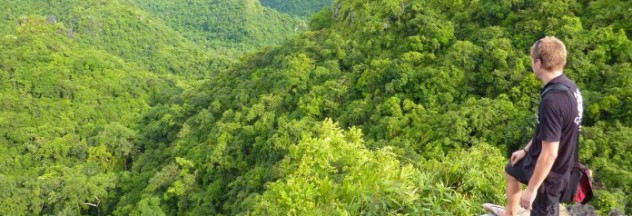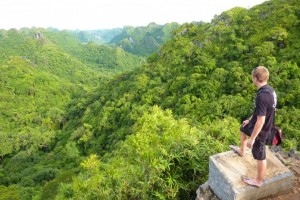Cat Ba Island is a haven in all sense of the word. It has immaculate beaches, dense forests, hundreds of untouched islands, ancient fishing villages and even a natural reserve for many endangered species. For the nature lover, this is heaven on earth.
Being a refuge for rare animals is one, if not the most, important role that Cat Ba plays. It is home to the white-headed langur, or Cat Ba langur as it is more commonly known, because it can’t be found anywhere else. At present, there are only 60 of the endangered creature left according to the data of the Cat Ba Langur Conservation Project.
Langurs sleep in caves and look for food in the mountains, whose diet includes leaves, fresh shoots, flowers, tree barks and certain fruits that are inedible to humans. They are spread all over the archipelago in smaller, hidden groups such as an all-female population which may be one crucial factor in their non-production and therefore declining status.
Being an ideal habitat for both animal and plant species, Cat Ba Island also houses over 3,800 other species of insular and marine flora and fauna. 130 of these are rare and recognized in the Viet Nam and World Red Lists, 76 of which are listed in the rare category of the IUCN, and 21 are endemic. It is considered “the most bio-diverse area in Vietnam” by the Institute of Marine and Environment Resources.
To date, Hai Phong City and Quang Ninh Province are working hand in hand and with great effort in collecting the remaining data required to nominate Ha Long – Cat Ba as an expanded World Heritage Site from its present temporary status at UNESCO. Under the expansion, Cat Ba will be divided into two criteria: aesthetic value and geomorphic and physiographic value; and additional two bio-diversity criteria for a new World Heritage Site (WHS) nomination. There are ten criteria for a WHS selection, six for cultural sites and four for natural sites. A site must also be of “outstanding universal value” in at least one criterion to be able to make it to the list.
Cat Ba Island is strictly managed by Cat Ba National Park, Management Board of Cat Ba Bay and the Management Board of Cat Ba Heritage. The archipelago has different layers of environmental protection: biosphere reserve with a core zone; buffer zone and transition zone; and a national park with special use area. Each has specific management requirements and policies.
About 1.7 million visitors enter Cat Ba annually. This figure is even expected to increase to 5-6 million by 2020 and 10 million by 2030. But while being recognized as a World Heritage Site by UNESCO greatly boosts the tourism of a place, the end goal is not profit gain but sustainable development. The white-headed langurs in particular run away and hide with just the scent of humans. Construction activities disturb the natural habitat of the animals and the island in general. When a place becomes nominated as a heritage site, it should be preserved of its natural state, not destroyed for consumerism. UNESCO has strict rules regarding this based on its “outstanding universal values” requirement.
Tourism is essential in order to attract tourists and investment for the development of a place. This equates to job creations, revenue gain and overall progress. But along with this should come responsibility and accountability, especially in a sensitive environment like Cat Ba which is the remaining refuge of the endangered white-headed langur. So while enjoying economic growth, the natural and cultural aspect must be firmly protected, which includes heritage sites, plants, animals, traditions and other crucial elements of a place. After all, that is what tourists visit a place for, its nature, history and culture which makes it truly beautiful to begin with.

